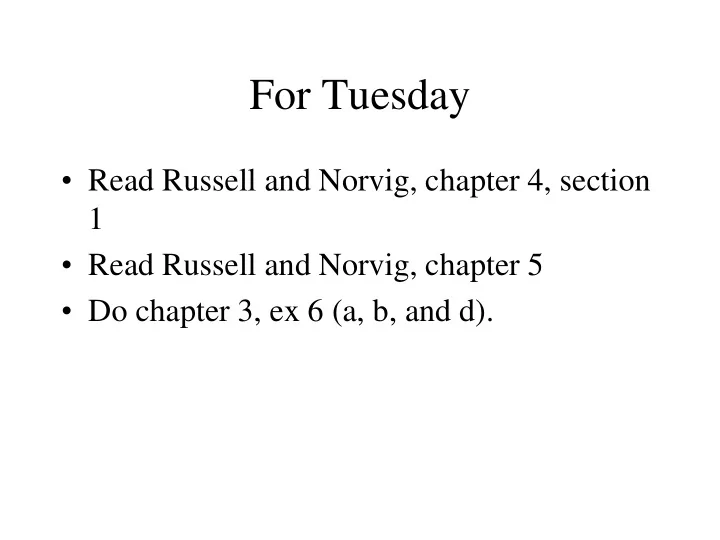

For Tuesday • Read Russell and Norvig, chapter 4, section 1 • Read Russell and Norvig, chapter 5 • Do chapter 3, ex 6 (a, b, and d).
Program 1
Late Passes • You have 2 for the semester. • Only good for programs. • Allow you to hand in up to 5 days late IF you have a late pass left. • Each good for +.05 on final grade if unused. • Must indicate that you are using a late pass in Blackboard when you submit. • Only way to turn in late work in this course.
Homework • Soccer • Titan • Shopping for AI books • Playing tennis • Practicing tennis • High jump • Knitting • Bidding on an item at an auction
Characteristics • Observability • Agents • Deterministic or stochastic • Episodic or sequential • Static or dynamic • Discrete or continuous • Known or unknown
Breadth-First Search • List ordering is a queue • All nodes at a particular depth are expanded before any below them • How does BFS perform? – Completeness – Optimality
Complexity of BFS • Branching Factor • For branching factor b and solution at depth d in the tree (i.e. the path-length of the solution is d) – Time required is: 1 + b + b 2 + b 3 + … b d – Space required is at least b d • May be highly impractical • Note that ALL of the uninformed search strategies require exponential time
Uniform Cost Search • Similar to breadth first, but takes path cost into account
Depth First Search • How does depth first search operate? • How would we implement it? • Performance: – Completeness – Optimality – Space Complexity – Time Complexity
Comparing DFS and BFS • When might we prefer DFS? • When might we prefer BFS?
Improving on DFS • Depth-limited Search • Iterative Deepening – Wasted work??? – What kinds of problems lend themselves to iterative deepening?
Repeated States • Problem? • How can we avoid them? – Do not follow loop to parent state (or me) – Do not create path with cycles (check all the way to root) – Do not generate any state that has already been generated. -- How feasible is this??
Informed Search • So far we’ve looked at search methods that require no knowledge of the problem • However, these can be very inefficient • Now we’re going to look at searching methods that take advantage of the knowledge we have a problem to reach a solution more efficiently
Best First Search • At each step, expand the most promising node • Requires some estimate of what is the “most promising node” • We need some kind of evaluation function • Order the nodes based on the evaluation function
Greedy Search • A heuristic function, h(n) , provides an estimate of the distance of the current state to the closest goal state. • The function must be 0 for all goal states • Example: – Straight line distance to goal location from current location for route finding problem
Beam Search • Variation on greedy search • Limit the queue to the best n nodes ( n is the beam width) • Expand all of those nodes • Select the best n of the remaining nodes • And so on • May not produce a solution
Focus on Total Path Cost • Uniform cost search uses g(n) --the path cost so far • Greedy search uses h(n) --the estimated path cost to the goal • What we’d like to use instead is f(n) = g(n) + h(n) to estimate the total path cost
Admissible Heuristic • An admissible heuristic is one that never overestimates the cost to reach the goal. • It is always less than or equal to the actual cost. • If we have such a heuristic, we can prove that best first search using f(n) is both complete and optimal. • A* Search
Heuristics Don’t Solve It All • NP-complete problems still have a worst- case exponential time complexity • Good heuristic function can: – Find a solution for an average problem efficiently – Find a reasonably good (but not optimal) solution efficiently
8-Puzzle Heuristic Functions • Number of tiles out of place • Manhattan Distance • Which is better? • Effective branching factor
Inventing Heuristics • Relax the problem • Cost of solving a subproblem • Learn weights for features of the problem
Recommend
More recommend